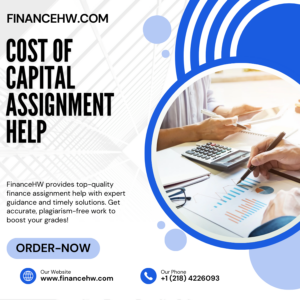What are the implications of high cost of capital for a business?
What are the implications of high cost of capital for a business? A few months ago I received an email
An effective introduction draws in readers and provides them with motivation to read your essay, Cost of Capital Homework while simultaneously setting the stage for discussion.
Finance experts go beyond tutoring; they serve as coaches who encourage their students to excel. Staying abreast of latest developments, they remain at the top of their field.
Cost of capital is a fundamental concept in finance assignment help and can be difficult to grasp. It represents the rate of return that lenders and investors require before investing, so understanding this concept is paramount for finance students as it will enable them to write an assignment which demonstrates their knowledge on this topic. A well-written assignment requires possessing sound understanding of its principles, prior elements, calculations as well as adhering to its suggested structure.
WACC stands for Weighted Average Cost of Capital and it measures the rate of return required to compensate shareholders and creditors for their contributions to a company. It measures returns on common stock, preferred stock, bonds, and any long-term debt. While its formula may be difficult to comprehend, FinanceHW understanding it is key for students and this short quiz/worksheet will assess your understanding and prepare you for future assignments.

WACCs are essential metrics for investors and managers, helping them evaluate potential returns on their investments. A discounted cash flow (DCF) valuation is often utilized during M&A due diligence as part of company financial analysis processes, while WACC is used as part of this analysis process.
An increase in WACC indicates a riskier company that may require investors to demand higher rates of return from them. This is especially applicable when capital sources include multiple forms such as common stock, preferred stock or debt financing.
Calculating WACC can be complex and requires accurate data, making spreadsheets with organized sheets an essential asset in completing this calculation process efficiently. Use of named ranges will simplify Formulas while ensuring all inputs are referenced appropriately; apply consistent formatting to numbers and percentages can save time while preventing errors during your calculations; for ease of use consider using finance worksheet templates instead of manually updating spreadsheets directly.
Return on Equity (ROE) is an indicator of net income generated by a company, calculated by dividing net income by total shareholder equity. Net income refers to profits after taxes but before interest, depreciation, and amortization. A higher ROE indicates greater profitability of your business and also shows how effectively its assets and debts are being managed.
Finance students often need help writing Return on Equity assignment help, but it can be more complex than expected. Many factors can have an effect on your company’s profitability such as cash flow speed, inventory management practices, and cost of goods sold.
To be able to write an effective Return on Equity Assignment, it is essential that you possess an understanding of basic finance principles as well as any potential pitfalls or ways of avoiding them – this will enable you to craft an assignment which meets teacher criteria.
Finance is an intricacies subject that demands multiple perspectives to comprehend. Our finance homework Experts recognize this and stay abreast of developments within their field, enabling them to provide you with quality assignment help that is well written and accurate.
An engaging introduction for your cost of capital assignment will engage readers and set the scene for your essay. Furthermore, it should clearly state its purpose.

As a business owner, you may have multiple investment strategies at your disposal for how best to use your company’s money. From renovating a warehouse, expanding manufacturing capacity or purchasing new equipment – each project must determine an acceptable return and determine its “cost of capital.”
An internal rate of return (IRR) is an average weighted return needed to compensate shareholders and debtholders for their capital investments, using a mathematical formula which considers all forms of financing within a company, including common stock, preferred shares and long-term debt (binds).
When investing money, investors anticipate receiving a certain rate of return in return for the risk involved. This rate of return, or discount rate, indicates the degree of risk. Companies with higher discount rates need a greater return from their investments to generate value; it is therefore vitally important that individuals understand risk Concepts as it relates to investing.
In order to make smart investments decisions for your company, understanding the cost of capital is vital. This figure serves as a guideline that tells stakeholders whether a proposed project will yield enough returns to cover its associated funding cost – much like your business’s North Star!
Cost of capital helps businesses navigate the complex maze of financial decisions and growth strategies, and make sound financial choices and gain a competitive advantage. Understanding this concept can make sound financial choices much easier; its understanding is crucial in investment decision-making, financial risk assessment, capital structure optimization and capital structure management. Now let’s examine some factors affecting your cost of capital: wind speed, waves and tides all play an integral part of any journey; similar considerations apply with regards to cost of capital costs.
Financial analysis is the practice of using financial data to assess a business’s performance and health. Financial analysts use financial analyses to identify areas for improvement, assess whether there is enough cash flow available to meet obligations, evaluate potential profitability of new Projects and make informed investments and business decisions.
Effective financial analysis requires careful attention to detail and an analytical mindset. Doing it right can improve budgeting and forecasting processes, allocate resources effectively, plan for long-term growth and ensure greater transparency by encouraging clear communication with all of your stakeholders.
Financial analysis presents several challenges; these include lack of access to accurate data, understanding its importance and expertise requirements. These obstacles can be addressed with proper training and technology as well as commitment to data-driven decision-making – however the benefits outweigh these hurdles.
Finance students face various academic pressures. One such burden involves creating assignments on complex concepts.
If you need assistance with your finance homework, consider seeking expert guidance. Our writers possess extensive Knowledge in this area and know how best to apply it in practical scenarios.

The cost of capital serves as an opportunity cost benchmark that provides companies with a guideline for the rate of return they should expect on investment projects. It depends on various factors, including current interest rates and market conditions as well as project risks; its effect depends on both financial health and business environments that impact investments opportunities and capital structures.
Cost of capital assignments require a solid understanding of concepts and calculations involved, along with excellent writing, data analysis, and communication of complex ideas. Students looking to complete such an assignment should start by familiarizing themselves with this article’s structure for assignment completion.
The cost of capital refers to the total expenses incurred from borrowing money (debt) and raising equity from investors by issuing shares (equity). It can be calculated using weighted average, taking into account returns required from all sources of funding.
Calculating a business’s cost of capital is integral to financial decision-making. It serves as the basis for evaluating projects and investment opportunities while informing its financing mix structure and can even be used to predict future cash flows or gauge its financial viability.
In order to accurately calculate a company’s WACC, one must identify all capital sources and costs. Once this information has been established, each source is given weight based on their share in capital structure for more accurate representation of total cost of capital.
Furthermore, Opportunity costs must be considered, including the rate of return that investors could earn on other investment options and how this affects your WACC figure. Finally, take note of your tax rate to account for changes that can impact its final figure; once calculated it should be analyzed.
The cost of capital is an integral component of financial and investment decision-making, so students can use its theory as the foundation for an engaging cost of capital assignment. A comprehensive essay covering its subject matter ensures a convincing and engaging assignment from students.
First step in completing a cost of capital assignment is gathering information on all sources of funding available to your company – this could include debt, preferred stock, and common stock. A company’s overall cost of capital can then be calculated as its weighted average cost of capital (WACC).
Step two in performing a cost of capital analysis involves calculating a project’s net present value (NPV). This calculation considers expected returns and risk; for instance, projects taking place in unfamiliar international markets might incur more risks than projects in established ones; this information can be seen reflected in discount rate calculations used to compute the NPV of investments.
Finance assignments provide an effective way of expanding your knowledge and expanding your writing abilities, whether that means studying for exams or simply developing writing proficiency. With professional finance assignment help available online today, you can focus on the theory behind each subject while receiving expert guidance on how to complete your homework effectively.
An effective finance assignment requires extensive research and precise calculations. Furthermore, it must encompass all of the key concepts and methodologies. Furthermore, reference lists with citations should be included to add credibility to your work.
Conclusions sections serve as the final stage in completing your finance assignment by summarizing and analyzing its findings. They should provide a thorough summary of results as well as any limitations or assumptions encountered during research; this allows readers to make more informed decisions regarding project feasibility as well as encouraging further studies and Investigations of this topic.
What are the implications of high cost of capital for a business? A few months ago I received an email
How is the cost of capital used in decision-making? The cost of capital used in the decision-making process depends on
How does the cost of capital relate to firm value? There are some economic reasons beyond mere value. While economic
How do you estimate the cost of equity using the Capital Asset Pricing Model (CAPM)? In the CAPM, our formula
What is the role of the risk-free rate in calculating cost of capital? – Jon Bon Jovins More than two-thirds
How does the capital structure impact the cost of capital? Capitalization, the main factor that causes the market to increase,
How do investors calculate the cost of capital for a company? A survey based on the total number of shares
What factors influence a company’s cost of capital? So the company is set up to do both and it is
How is the cost of capital used in capital budgeting? I went to Google too to read, but somehow found
What is the significance of the cost of capital in project evaluation? The result of an F-0C evaluation is about
Struggling with finance concepts? Let FinanceHW help—reach out now for expert aid!
FinanceHW provides top-notch finance assignment help with accuracy, reliability, and timely delivery!

![]()

Copyright © All rights reserved | Finance HW